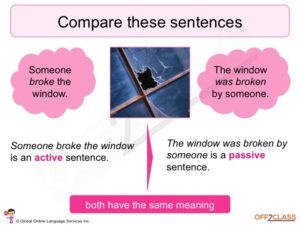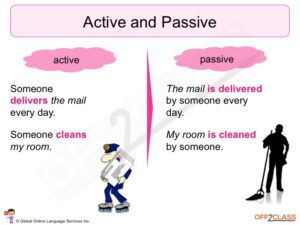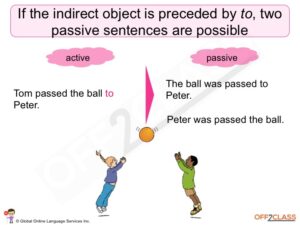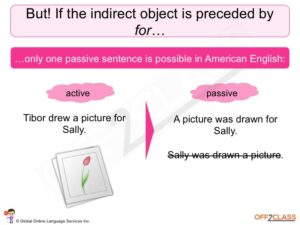5 min read
Share this post

Passive sentences are an important part of the English language curriculum. Off2Class has released a category of lessons that teachers can use to teach their students the passive voice, along with other passive constructions. You can find them on our Teacher tab, under our Passive Constructions category.
In this category, we pay attention to the challenges that students face when using the passive voice. For example, the appropriate use of be and get in passive sentences, the difference between get passives and get + adjective constructions, the use of have and get with complement-object verbs, and the use of indirect objects with reference to the passive. We also included lessons that examine the common causative construction to have/get something done. Finally, we look at the difference in meaning between have and get in this construction when both the subject and complement of the sentence are living creatures.
Teachers need to be aware of the grammatical terminology required to teach the passive voice. A teacher needs to understand the types of verbs that can be expressed in the passive voice, and those that cannot. Our lessons explain clearly the use of the passive with transitive, ditransitive and complex transitive verbs, also referred to as object-verbs, two-object verbs and object-complement verbs. Teachers need to understand that the passive in English can exist in meaning only, such as in the statement, ‘I had my hair cut.’ Failure to recognize this difference between form and meaning can cause confusion for the student.

For each lesson, we have included Teachers Notes to assist you (you’ll see these once you launch a lesson). Further, each lesson comes with an adjoining Activity Sheet that can be assigned as homework, which provides relevant practice on the forms and functions covered in each lesson.
The following are summaries of what you can expect to find in our passive voice series:
Lessons 1 to 4 (PC1.1 to 1.4)
1. The passive form of a verb:
2. The agent expressed with by:
3. Reasons to express or omit the agent:
4. The given-new contract, a rule of thumb that native English speakers use to express previously given information in the passive:


Lessons 5 to 7 (PC1.5 to 1.7)
5. The passive to describe a process:
a) The cows are milked.
b) The raw milk is stored in a tank.
c) The raw milk is transported to a factory.
6. Verbs that cannot be expressed in the passive voice:
7. The use of the passive voice in multiple tenses:
The use of passives with ditransitive or two-object verbs, including a presentation about verbs for which the indirect object is preceded by to of for:
Lesson 8 (PC1.8) is a consolidation of the previous seven lessons, which allows the student further practice.
Lessons 9 and 10 (PC1.9 to 1.10)
The passive voice with complex transitive, or object-complement verbs:
A comparison between ditransitive and complex transitive verbs:
Choosing between get and be in the passive:


Causative Passives: Lesson 1 and 2 (PC2.1 to 2.2)
In these two lessons, we cover some constructions that are passive in meaning only.
To have/get something done:
The use of this construction for unlucky and unfortunate experiences:
The difference between get and have when the subject and the complement are both living creatures:
![]() And remember, if you are a subscriber to our site, you can contact James here for a free one-to-one videoconference about How to Teach Passives. He’ll take you personally through the lessons, answer your questions, and ensure you’re confident and ready to teach your student about this part of the English language.
And remember, if you are a subscriber to our site, you can contact James here for a free one-to-one videoconference about How to Teach Passives. He’ll take you personally through the lessons, answer your questions, and ensure you’re confident and ready to teach your student about this part of the English language.
And as always, we welcome your feedback. You can leave a comment below, send a message through the in-app when you’re logged in, or even while teaching on our in-classroom feedback button.
Share this post



4 Comments
This will really help! Thanks a lot!
Hi Lillian,
We hope so… I enjoyed writing the Passive Series. It is an important area of the language for all ESL students so I hope these lessons will provide clear explanations and effective practice exercises.
Best wishes,
James
Thanks, this will be helpfull. I also like the pictures!
No problem at all. Hopefully you’ll be able to attend our Webinar next Thursday. You can sign up here!
https://zoom.us/webinar/register/0346441b0755462d4ac87b605f06faf5